Easy Seaweed Recipes For People Who Need More Minerals In Their Diet
Add More of Japan's Superfood Into Your Meals
Seaweed is packed with essential vitamins and minerals, and is also low in calories and fat, making it one of Japan’s best ingredients for healthy eating. Here are several easy and delicious ways to cook it at home.
In the past, I wrote a general guide to Japanese seaweed, its health and beauty benefits and why you should eat this superfood more often than not. This time, I’m here to introduce some easy seaweed recipes you can add to your diet to reap all of its benefits.
By now, you know that seaweed provides us with several essential nutrients, including:
- Fiber
- Iron
- Iodine
- Zinc
- Magnesium
- Vitamins A, C and B
Seaweed is also a wonderful source of antioxidants, which are known to have anti-inflammatory and cardiovascular benefits. You may also know that other wonderful health benefits of seaweed include helping to improve the symptoms of osteoarthritis, assisting with weight loss and helping moderate blood sugar levels.
Now, all that’s great, but—aside from eating sushi all day and adding some dry seaweed to your miso soup—are there any other easy ways to incorporate this superfood into our diet without having to sign up for Japanese cooking classes? To encourage you to give seaweed a try, here are five easy recipes that will help you fall in love with seaweed—or at least have it a bit more often. Enjoy!
1. Seaweed Chips
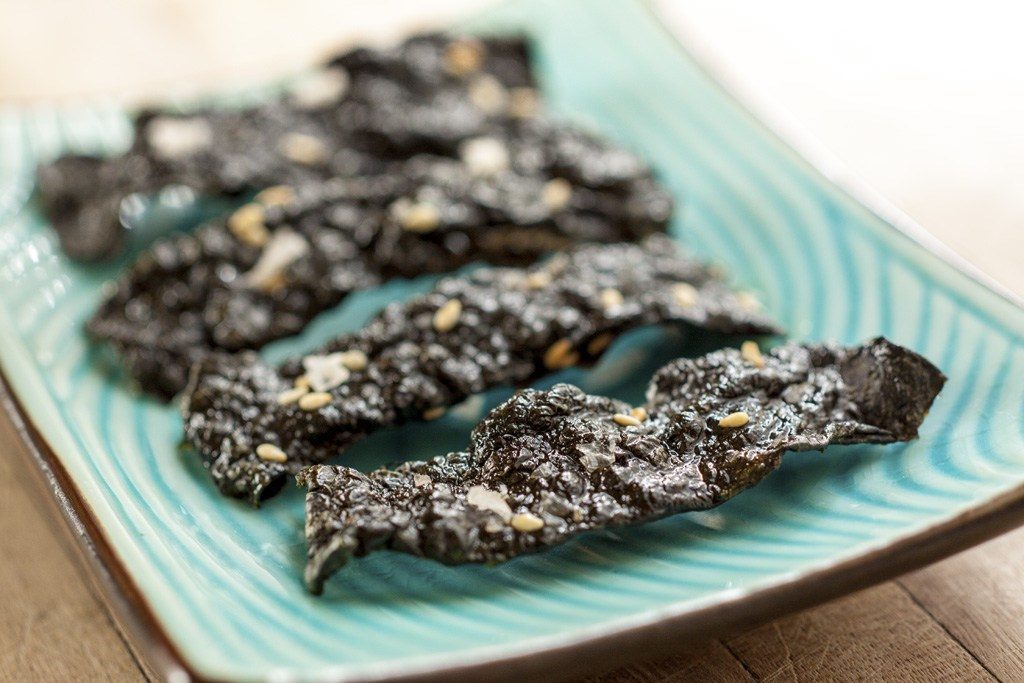
This is a great recipe for a yummy and healthy alternative when you’re craving something to snack on.
Ingredients
- 5-6 sheets of roasted seaweed
- 2 teaspoons sesame oil
- Sprinkle of sesame seeds (optional)
Seasoning Mix:
- 1/2 teaspoon brown sugar
- 1/4 teaspoon karashi (Japanese mustard)
- 1/4 teaspoon paprika
- 1/4 teaspoon salt
- 1/4 teaspoon ground ginger
Instructions
- Mix all the Seasoning Mix ingredients in a small bowl.
- Brush a bit of sesame oil onto one side of a seaweed sheet. Generously sprinkle the seasoning mixture as evenly as possible on the oiled side. Repeat for all the seaweed sheets.
- Heat a nonstick pan over medium-high heat until hot. Lightly toast each side for about 10-15 seconds.
- Cut each sheet into smaller pieces of your preferred shape and serve with a sprinkle of sesame seeds!
2. Kombu Tsukudani
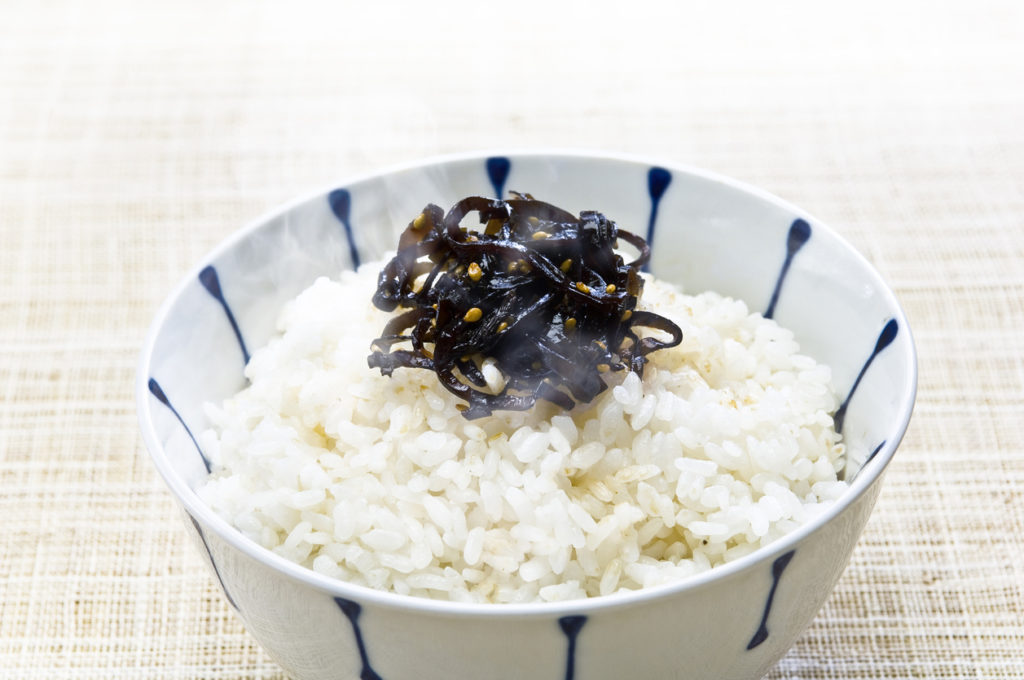
Kombu tsukudani is thinly cut kombu seaweed cooked and seasoned mainly with sugar and soy sauce. It is a Japanese household staple and is often used as a delicious accompaniment for plain rice (like tsukemono pickles). You can top a bowl of rice with it or mix it into your onigiri rice balls.
Ingredients
- 15g dried kombu
- 1/2 cup (120ml) water
- 1/2 tsp rice vinegar (komezu, 米酢)
- 3 tbsp soy sauce
- 1 tbsp sake for cooking (ryorishu, 料理酒)
- 1 tbsp mirin (みりん)
- 1 tbsp sugar
- 1 tsp sesame seeds
Instructions
- Place the kombu in a large bowl of water and leave it for about 15 minutes until it has absorbed most of the water.
- When the kombu becomes soft, remove it from the water and pat dry. Then, slice it into two long, thin strips.
- Put 1/2 cup water and vinegar along with cut kombu in a small pot. Cook at medium-low heat for 10 minutes. Then add all the seasonings, and cook until the liquid is gone. Add sesame seeds and mix.
3. Pickled Cucumber & Wakame Salad
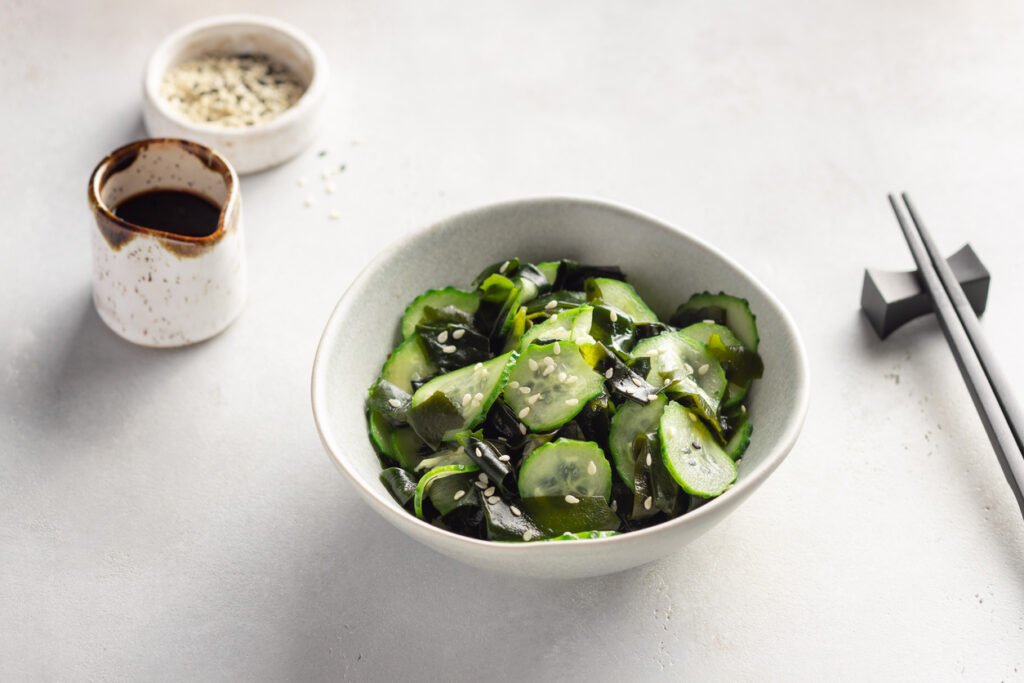 © Photo by iStock: Mila Naumova
© Photo by iStock: Mila NaumovaSunomono is a type of pickle commonly used as a side dish in a classic Japanese teishoku-style dinner. Cucumber and wakame sunomono is one of the most common sunomono because it’s super easy to make and a very healthy salad that can also cool you down on hotter days. Use it as a side dish, a salad, an appetizer or as an addition to a full-course Japanese meal.
Ingredients
- 2 tbsp dried wakame seaweed
- 2 -3 cucumbers
- 1/4 tsp salt
- 3 tbsp rice vinegar
- 1 tbsp sugar
- 1/4 tsp soy sauce
- 1/2 tsp sesame oil (optional)
- 1 tsp sesame seeds
Instructions
- Place dried wakame in water and leave for about 10 minutes. Drain the water and squeeze the wakame until nearly dry.
- Slice the cucumbers as thinly as possible. Stir in salt and let sit for five minutes. Squeeze extra water from the cucumbers.
- In a small bowl, mix rice vinegar, sugar, soy sauce and sesame oil until the sugar dissolves.
- Add the vinegar mixture and sesame seeds to the cucumbers and wakame and mix well. Serve as you wish and enjoy while cool.
4. Japanese Hijiki Salad
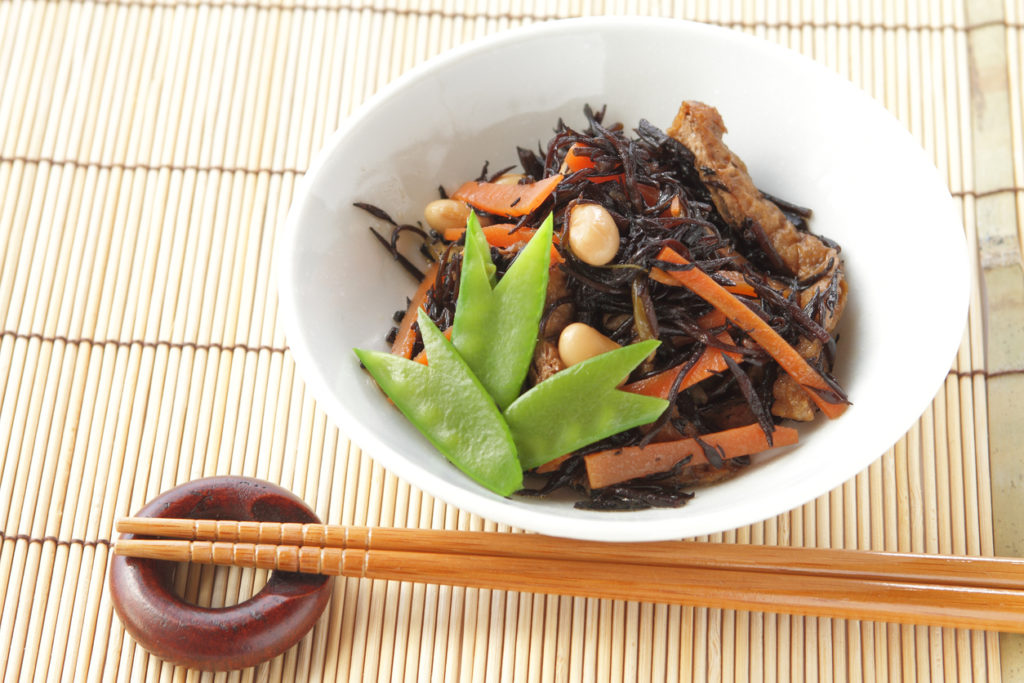 © Photo by iStock: yumehana
© Photo by iStock: yumehanaHijiki salad or hijiki no nimono is a delicious Japanese side dish loaded with both sea and land vegetables. Although it’s a cooked dish, it’s typically served cool or at room temperature. If you serve it hot out of the pan, it’s going to taste a little bland, but leave it in the fridge overnight, and you’ll be treated to a mouthful of earthy, briny, nutty flavors.
Ingredients
- 20g dried hijiki soaked in 1L water for 1 hour
- 2 abura-age (fried thin tofu) slices
- 80g carrot cut into matchsticks
- 40g frozen edamame (or soy) beans
- 2 tbsp sesame oil
Dressing:
- 150ml dashi stock
- 2 tbsp soy sauce
- 1.5 tbsp sugar
- 1 tbsp sake
Instructions
- Drain the rehydrated hijiki using a sieve and rinse a few times.
- Pour two cups of hot water over abura-age to remove excess oil, then squeeze the water out. Cut each abura-age in half lengthwise, then cut into wide strips crosswise.
- Boil frozen edamame for a few minutes and drain.
- Add sesame oil to a saucepan and heat over high heat. Add carrot and stir-fry for 30 seconds.
- Add hijiki and stir-fry for about a minute. Add abura-age and stir-fry for another 30 seconds.
- Add the Dressing ingredients and mix well. Reduce the heat to medium and cook for 7-8 minutes until most of the liquid evaporates. Toss the pot a few times while cooking so that the ingredients get coated with sauce evenly.
- Add edamame and mix, then turn the heat off.
- Serve in a large bowl to share or individual small bowls.
5. Seaweed Omelet
 © Photo by iStock: jreika
© Photo by iStock: jreikaThis aonori tamagoyaki or seaweed omelet is one of the easiest ways to spice up your breakfast or brunch while enjoying the health benefits of seaweed. It’s also an impressive addition to a beautiful obento!
Ingredients
- 2 eggs
- 1 tbsp. dashi or milk
- 2 pinches salt
- 1 tbsp. aonori (soft or powder)
- 1 tbsp cooking oil
Instructions
- Place the eggs in a bowl and whisk well until smooth.
- Add the aonori to the eggs and mix well again.
- Heat the oil in your pan on medium heat. Pour 1/3 of the eggs into the pan.
- Spread out the eggs and let it cook a few seconds.
- When it’s a bit cooked, roll! Roll again and roll again! Push the eggs to the back of the pan.
- Add another 1/3 of the eggs and lift the cooked eggs a little and let the new eggs drain a little underneath.
- Let cook for a few seconds, then roll everything towards the form again.
- Roll again until all rolled up.
- Push the rolled eggs to the back of the pan again. Then add the last 1/3 of the eggs (add a little bit more oil if you think the eggs might stick to the pan), then repeat the previous steps.
- Allow to cool slightly, cut and serve. Enjoy!
Bonus Add-Ons
For the extra busy or lazy ones among us, here are some completely effortless ways to get some seaweed boost without spending hours in the kitchen:
- Add a sheet of nori seaweed to a wrap or sandwich
- Add small bits of nori to your salads or sautéed veggies
- Add seaweed to soups
- Add extra wakame to your miso soup with wakame
- Add in dried seaweed when making dips like hummus, tapenade and pesto
- Order a seaweed salad next time you’re dining out
Which of these seaweed recipes do you want to add to your diet?












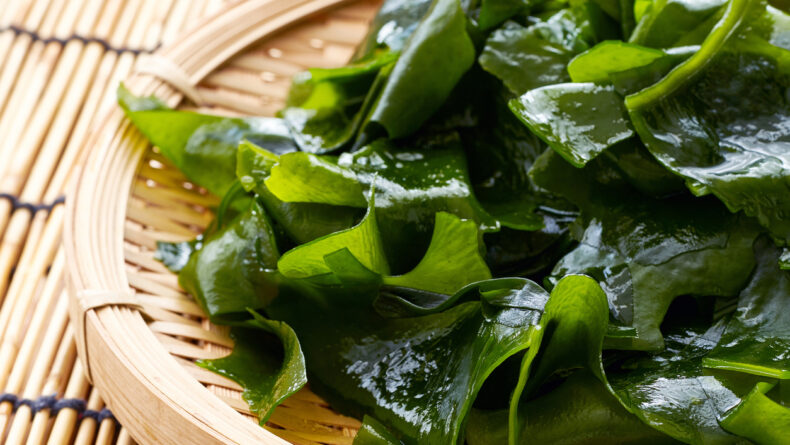
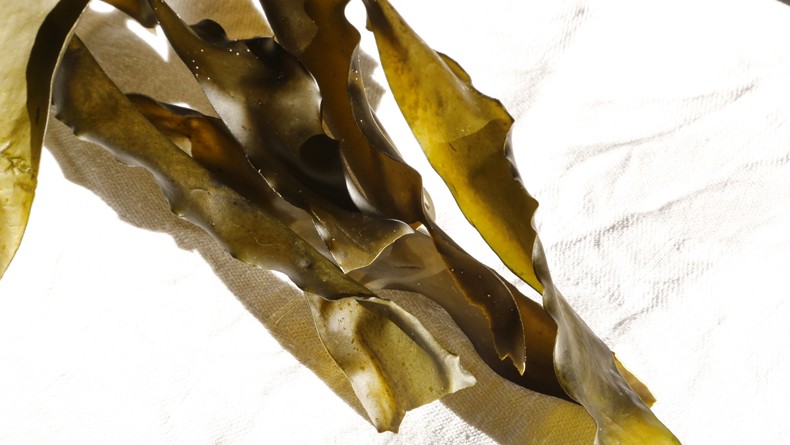
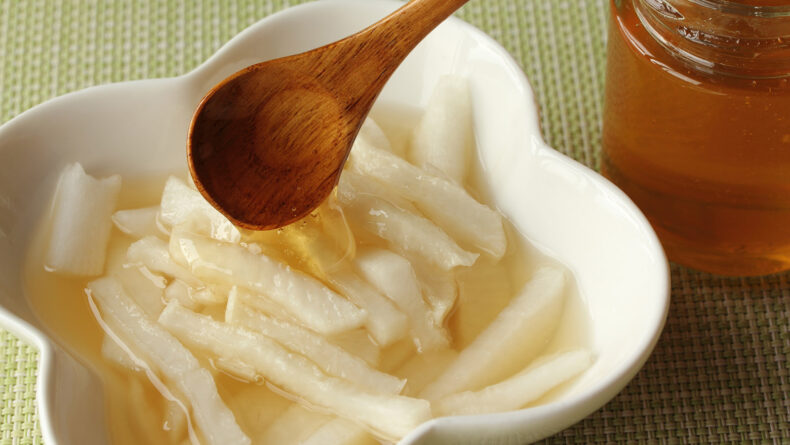
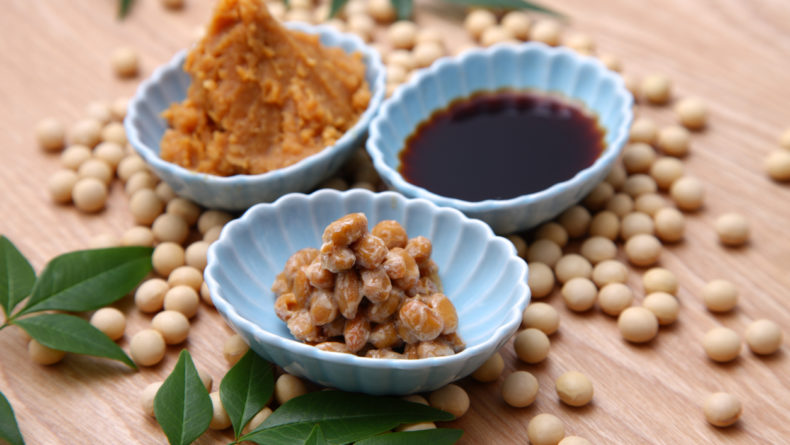
Leave a Reply